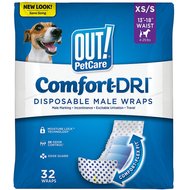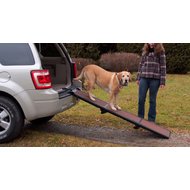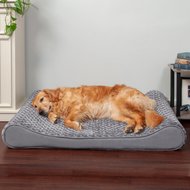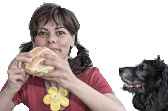Caring for a senior dog with incontinence
Sometimes older dogs may have a problem with incontinence, especially when they are sleeping. A low-grade bladder infection may be the cause, in which case your vet will prescribe an antibiotic. If incontinence is a result of weakening muscles, your vet will prescribe medications to stop or lessen the problem. Take your senior dog out for short but frequent walks. As your dog is getting older, it may be more difficult for the older dog to control his bladder for longer periods of time. More frequent walks can help in such situations. One way to help alleviate accidents is to make sure that your dog goes outside regularly. Let your senior dog out every 4 hours. Everyone benefits from this increased schedule. Many senior dog owners know that incontinence in an aging dog can dramatically increase the amount of care the your dog requires on a daily basis. Taking care of a senior dog that is losing control of his or her bladder can be much easier with the use of dog diapers that are specifically made for older dogs with incontinence.
For senior male dogs there is a wide selection of male dog wraps that are easy to use and can make the life of your pet a lot more comfortable. Older female dogs may also suffer from incontinence and there are many female dog diapers available that can make your life easier and your pet more comfortable. Disposable and reusable dog diapers present a great solution for owners of older pets with incontinence issues.
OUT! Disposable Male Dog Wraps are designed for male dogs and come in different sizes to choose from. Disposable diapers are an easy way to keep your pet dry and comfortable throughout the day and at night.

Invest in a comfortable dog bed for your pet and place it away from cold drafts. Protect your older dog's aging joints by adding some padding to his bed. If he's always slept on three or four folded towels, put a foam pad on the bottom. Many senior dogs suffer from arthritis which makes it painful to jump.
Pet Gear Full Length Tri-Fold Pet Ramp is a product that owners of senior dogs can really appreciate. If you take your dog for car trips this pet ramp will make it easy for your dog to get in and out of car without having to jump and cause pain to the arthritic joints.

Make sure that your pet has an easy access to his bedding where the dog doesn't need to jump up and can just step into his bed.
FurHaven Ultra Plush Luxe Lounger Orthopedic Cat & Dog Bed w/Removable Cover is one of the most comfortable dog beds for senior dogs. This dog bed is orthopedic and it comes in different sizes.

How to care for a senior dog that is overweight
Being overweight is not healthy for you or for your pet. There are plenty of diseases caused by excess body weight for your dog, such as high blood pressure, diabetes, heart issues, joint pain, etc. Life span for obese dogs is much shorter.
There is a simple test to see if your dog is overweight. Try to touch your dog's back and if you can't feel the backbone and the ribs behind an excessive layer of fat - chances are your pet is overweight. Keep in mind that most dog breeds will have a "waist" and there should be a small layer of fat on the chest of your dog that is in normal weight. You can also try to find some information online that applies to your dog's breed and weight. See if your dog's weight fits the normal weight limits for it's specific breed.
How can you ensure that your pet stays in a healthy weight?
Feed your pet with dog food that your vet recommends.
Provide enough exercise especially if you notice that your dog is starting to gain extra weight.
Use toys for dogs that will help your dog to stay active.
Make sure your dog gets enough drinking water.
Every dog needs to be walked several times a day to take care of his needs and to get enough exercise.
Do not feed your dog human food as human food does not provide your pet with the appropriate nutrients that your dog needs to stay healthy. Feeding your dog with human food can contribute to weight gain in dogs.
Older dogs should be fed twice a day, preferably after the morning walk and after the evening walk. Some senior dog owners only feed their pet once a day and for an active animal it is simply not enough. Feeding an aging dog once a day increases the chances of developing bloat. When the dog eats only once a day, he gets very hungry and quickly swallows food, increasing the chances of swallowing more air along with food which may contribute to developing bloat. Slow feeder dog food bowls can help to slow down the dog as he is eating. If you have a large dog breed with a deep chest, consider getting a slow feeder for the dog to help minimize the chances of him developing bloat.
Food should be consumed within half an hour. Leftover food should be removed after 30 minutes. Do not feed your dog with human food during the day. Bad habits are easy to create but difficult to correct.
Provide your senior dog with high quality dog food formulated for older dogs. Pay attention to your dog's weight and avoid overfeeding your dog. Extra weight takes toll on your pet's overall health and the extra weight can speed up the development of joint pain.
Senior dogs may not be as enthusiastic about mealtime as during the young years. Aging affects many aspects of your dog's life, including his sense of taste. As a dog ages, his taste buds become less sensitive. As dogs age, they start losing muscle strength and bone mass, so good nutrition is especially vital to his good health. If the change seems sudden or is accompanied by other symptoms, consult your veterinarian. If a waning appetite is gradual, try to warm up your dog's wet food, or add some water to dry food, heating it before serving. By doing so, you will release the meal's aroma. This can also make kibble easier to chew, which may be a concern for older dogs. Instead of feeding your elderly dog just once or twice daily, consider dividing his food into several smaller meals. Keep the choices healthy, but avoid hard foods which may be more difficult to chew. As long as your dog is not suffering from kidney disease (in which case you would want to limit protein), you might be able to lure your older dog back into eating by adding foods such as meat and fish to the menu. Cottage cheese and hard-boiled eggs are also enticing protein-rich additions that can be added to the daily grind.
What not to feed dogs
 We all know the begging look that your dog displays every time you're about to eat something delicious. Nevertheless you should never let your dog try the following foods as these can be dangerous for your pet's health: We all know the begging look that your dog displays every time you're about to eat something delicious. Nevertheless you should never let your dog try the following foods as these can be dangerous for your pet's health:
Never let your dog have sweets that are meant for humans. Sweets are oftentimes aren't healthy for humans and even more so for your dog. Chocolate, for example, can negatively affect your dog's nervous system and heart functioning. After eating chocolate your dog may experience swelling, digestive system issues and heart rate changes.
Meat products that are meant for humans. Sausages, hot dogs and kielbasas aren't good for your dog either. These often contain unhealthy for your pet preservatives, fats, etc. Dogs quickly get accustomed to eating these types of foods and start refusing eating dog food. This creates unhealthy eating habits that lead to your dog gaining extra weight and other health issues.
Fruits. Fruits are healthy for humans but for dogs fruits can cause a variety of health issues. Grapes, for example can cause kidney problems in your pet.
Feed your dog a high quality dog food from an early age so that the dog doesn't get used to eating food meant for humans. Feeding your dog human food even once in a while may cause your dog to start refusing eating the healthy dog food. Once your dog is introduced to the human food you may notice that the dog becomes more picky about dog food and the dog will beg for human food instead. Human food does not provide all the necessary nutrients that your dog needs to stay in optimal health. Eating mostly human food may cause various health issues for your dog, including dental problems, heart conditions, being overweight, joint issues, low energy and many other problems. Some dog breeds are prone to food allergies and your dog may experience upset stomach and skin rashes. Try feeding your dog a breed specific dog food and if that doesn't help with food allergies then check with your veterinarian about most appropriate dog food options for your pet. Provide your dog with dental dog treats a couple of times every week to keep your dog's teeth healthy and its breath fresh. Young puppies have different food needs than adult or senior dogs. Small dog breeds may have a tough time eating a dog food that is meant for large breeds. Pay attention to the following factors when selecting the appropriate dog food for your pet: age of your dog, size of the breed of your dog and the breed of your dog. If your dog has any food allergies then you may need to try several different brands of dog food before you find the one that does not trigger an allergic reaction in your dog.
Switching to a different dog food without causing digestive issues in your pet
Adult dogs should be fed twice a day, with a high quality, age-appropriate dog food formulated for the size of your pet. Can you give treats to your best friend between meals? Sure! Get healthy dog treats from a pet store and don't forget to let your dog have a nice rawhide bone to chew on. Dog treats work great as food motivators during training sessions. And rawhide bone keeps the dog busy chewing on something that actually helps to maintain healthy and clean teeth.
Even if your dog looks great as it approaches its senior years remember to visit your veterinarian and to make sure that your senior dog is healthy as some canine illnesses may go unnoticed for a while. Many illnesses are easier to treat during the early stages.
An older dog may not have as much energy as during the younger years as a result it needs less demanding physical activities as the dog ages. During your walks pay attention to how your dog is feeling and watch out for any signs of tiredness. Continue to play games with your dog. If your dog has always enjoyed a game of fetch, don't eliminate the game; just make it shorter. Even if your senior dog has arthritis, moving is important. The movement keeps the muscles in shape and alleviates pain in the long run. If your daily walks have always been three times around the block, once around may now be all your dog can comfortably manage. At least you and your dog are still taking the time to walk together. Understand your aging dog's limits and adjust to his exercise needs.
Older dogs may not be able to hop into the car or jump on his favorite couch. Dog ramps can be helpful with an older dog during car trips. Your senior dog can use the ramp to easily get into the car without having to jump.
It is never too late to teach your senior dog a new command. Mental exercises help to keep your senior dog's mind sharp.
Pay attention to signs of arthritis in your dog such as limping or refusal to go up or down the stairs. These behaviors in your pet may be signs of arthritis. Take the dog to the veterinarian as soon as possible. Arthritis can be extremely painful for your dog and the veterinarian can help to find the best way of reducing the discomfort caused by painful arthritis.
Hearing loss in older dogs
Hearing loss is an issue that many older dogs may face as they are approaching senior years. If senior dog is showing signs of hearing loss, start relying more on visual commands. Remember to keep your older dog on a leash during walks as your pet may not be able to hear your call and may get lost. Approach a deaf dog from the front so that the dog can see you and avoid being shocked by a sudden touch. People who do not realize their dog is deaf sometimes think she's just stupid or stubborn. There are ways to communicate with a deaf dog. For example, by thumping on the floor to get her attention and then using hand signals to tell her what you want. You can blink a flashlight on and off to call the deaf dog when it's dark.
Here's a simple hearing test you can do with your older dog at home. Stand behind your dog and say a word or a phrase that she should know, such as her name, or "Want to go out?" or "Ready to eat?" If she responds, she probably can hear. If she doesn't respond, try another dog hearing test. Wait until your dog is panting, and then make a noise and see if she quits panting for a moment. Most dogs will quit panting when they hear a strange noise so they can listen better. If your dog responds by stopping her panting for a second, she probably can hear just fine.
Vision loss in older dogs
If you notice that your senior dog is beginning to lose vision, take the dog to the veterinarian. How to tell if your dog is blind.
There is an easy way to test your dog's vision. Throw a cotton ball and see if your dog follows it with his eyes. A cotton ball is used because it doesn't make any noise when it hits the ground. You can also try an obstacle vision test. Take your dog to a room he is not used to, or rearrange some furniture in one room. Use only soft pillows, chairs and things that won't hurt your dog if he bumps into them. Then let the dog loose in the room and call him from one side to the other. A dog with normal vision should not bump into any objects. In some cases the vision loss is caused by a cataract and the veterinarian may be able to help in such case. Avoid moving furniture as your blind dog may have difficulty getting used to the new space because it can no longer see. If there are sharp furniture corners then you can wipe these corners with vinegar. The smell of vinegar will alert your blind dog of the obstacle on its way. Blind dogs can live full lives. Blind dogs learn their way around furniture in the house and their other senses can help them feel comfortable even when completely blind. Sounds such as radios, ticking clocks, wind chimes and scents can guide a blind dog around the house.
Anal sac care
The anal sacs are two small glands just inside your pet's anus, packed with terrible-smelling secretions, whose purpose is not entirely understood. Wild animals can empty them on command to mark territory or for self-defense, but domestic dogs can't seem to do this. How do you know if your dog needs glands expressed? The sacs usually empty when the dog defecates, but sometimes they become impacted, and you will see your dog scoot around on this rear end. You can learn to empty the sacs by holding a tissue against the anus on each side and squeezing them. Sometimes it takes several tries. If an impacted anal sac is not emptied, it can form an abscess and rupture out through the skin. This situation calls for veterinary treatment and a course of antibiotics.
If your dog continues to have trouble with his anal sacs, you can try switching him to a higher fiber diet. This produces a bulkier stool that may help empty the anal sacs when the dog defecates.
When to take dog to vet?
In many cases when a dog is not feeling well, the owner may be wondering if it is time to take the sick dog to the veterinarian or is it best to just wait and see if the dog will get better on its own. See below for signs that call for immediate medical care.
The dog's appetite or water consumption changed
Bad breath, yellow build-up on teeth (tartar), red gums or broken teeth
Hair loss, itchy skin and the dog is constantly scratching, chewing or licking its skin
The dog is appearing lethargic and sleeps more than usual
Changes in behavior that include fearfulness, aggression, or any other sudden behavioral changes
Scratching or shaking the head, tender ears, or ear discharge
The dog is unable or is having difficulties with urinating
Itching, redness or cloudiness in the eyes, unusual discharge from the eyes
The dog is appearing to be stiff and you are noticing reluctance to rise, sit, use stairs, run or jump
You are noticing changes around the abdomen area - it is appearing large, tight or there can be pain in the abdomen area
Dog's coat appearing dull, or there is hair loss
You are noticing any abnormal shaking, trembling, or excessive involuntary tremors
Sudden changes in weight
The animal is straining to defecate, bleeding, licking of the area around the rectum, or smelly discharge
Dry, scaly, sometimes itchy hairless patches on face or paws
The dog bruises easily or bleeds a lot from a small wound
Coughing, exercise intolerance, rapid breathing at rest
|